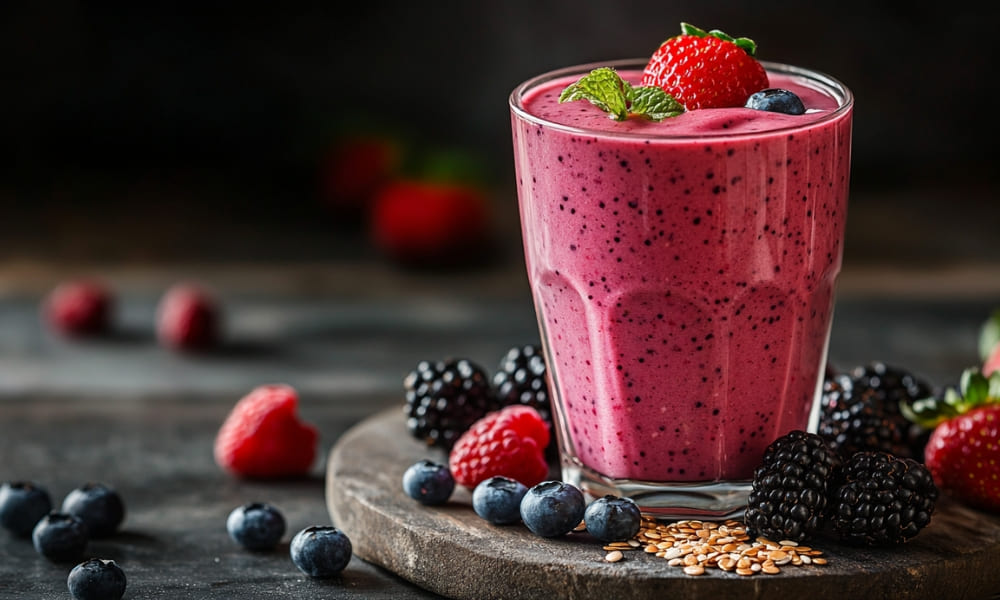If you’re cutting back on sugar but still want something satisfying, quick, and genuinely good for you, low sugar smoothies may be exactly what your routine needs. Designed to support steady energy, fat metabolism, and hormone balance, these smoothies offer a practical way to nourish your body—without the blood sugar rollercoaster. Whether you’re starting your morning or refueling after a workout, the right blend can help you feel full, focused, and in control.

Why Go Low-Sugar?
Choosing low sugar smoothies is a simple yet effective way to support your health goals—especially if you’re watching your weight or managing hormone fluctuations. Unlike traditional smoothies that often rely on high-sugar fruits or added sweeteners, low sugar options help stabilize blood sugar levels, reduce energy crashes, and curb cravings throughout the day.
They’re particularly beneficial for women, as keeping sugar intake in check can support balanced hormones, improve mood, and promote sustainable fat loss. By focusing on whole ingredients that are naturally low in sugar but rich in fiber, healthy fats, and nutrients, you can enjoy smoothies that are both nourishing and satisfying—without the sugar spike.
What Makes a Smoothie “Low Sugar” But Still Tasty?
Creating low sugar smoothies that are both enjoyable and supportive of your goals starts with understanding how ingredients affect your blood sugar, energy levels, and cravings. The key is to be intentional about what you include—balancing flavor with function.
Smart Fruit Choices: Flavor Without the Sugar Spike

Not all fruits are equal when it comes to sugar content. While fruit offers vitamins and antioxidants, some varieties are loaded with natural sugars that can cause insulin spikes—especially when blended. Choosing lower-sugar fruits helps minimize this response without sacrificing flavor.
Best low-sugar fruits to use:
- Berries – Rich in fiber and antioxidants, berries add sweetness and color without a high sugar load.
- Avocado – Technically a fruit, avocado is sugar-free and adds a creamy texture with healthy fats.
- Watermelon – Refreshing and hydrating, watermelon is relatively low in sugar per serving due to its high water content. Use in moderation.
- Kiwi – Slightly tart, kiwi brings vitamin C and a unique flavor with a moderate sugar level.
- Lemon or lime juice – Adds brightness and balances out bitterness or bland flavors without adding sugar.
Fruits to limit or avoid:
- Bananas, mango, pineapple – While nutritious, these are high in natural sugars and can quickly raise your smoothie’s sugar content.
Natural Sweetness Without Added Sugar

Low sugar doesn’t have to mean bland. There are several ways to naturally sweeten your smoothies using ingredients that don’t spike blood sugar.
Flavor enhancers that add perceived sweetness:
- Cinnamon – Adds warmth and depth; may also help improve insulin sensitivity.
- Vanilla extract – Boosts aroma and enhances the overall sweetness of other ingredients.
- Cacao powder – Offers a rich chocolate flavor without sugar. Best paired with a touch of sweetness for balance.
Natural sweeteners to consider (used sparingly):
- Monk fruit and stevia – Zero-calorie plant-based sweeteners that provide sweetness without carbs or sugar.
- Dates – Naturally sweet and fiber-rich; use just one to avoid tipping your sugar intake too high.
Balancing Ingredients for Fat Burning & Satiety
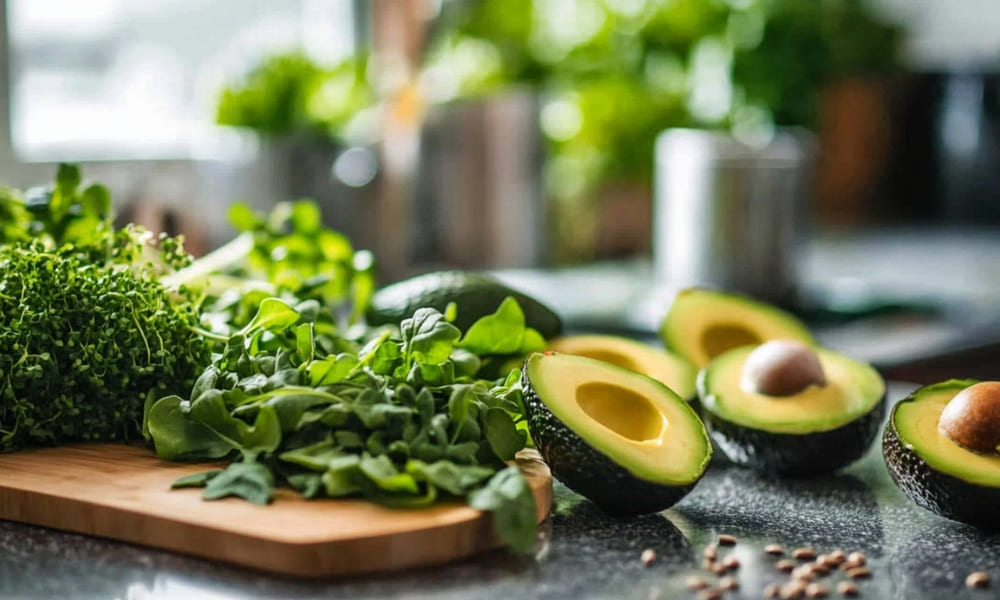
A smoothie that’s low in sugar but lacks protein, fat, or fiber may leave you hungry an hour later. Including ingredients that slow digestion and promote fullness helps regulate appetite, reduce cravings, and support fat metabolism.
Healthy fats:
- Nut butters (almond, cashew, sunflower) – Add creaminess and slow digestion.
- Chia or flax seeds – Offer healthy omega-3s and support hormone function.
- Avocado – A versatile fat source that blends smoothly and helps stabilize blood sugar.
Fiber:
- Leafy greens – Spinach and kale are low in sugar, high in fiber, and nearly tasteless when blended.
- Chia or flaxseed – Both support gut health and help you feel fuller longer.
Protein:
- Greek yogurt (unsweetened) – Provides a creamy base and supports muscle recovery.
- Protein powders – Choose clean, low-carb options with no added sugar. Look for ones designed for women’s metabolic and nutritional needs.
By combining these ingredients thoughtfully, you can enjoy low sugar smoothies that not only taste great but also work with your body—supporting energy, satiety, and fat burning without the sugar rollercoaster. It’s not just about what you leave out, but what you put in that makes the difference.
5 Delicious Low-Sugar Smoothie Recipes
Finding the right balance between flavor and function is key when making low sugar smoothies—and the good news is, you don’t need added sugars or high-sugar fruits to create blends that are both satisfying and supportive of your goals.
Below are five real-food recipes crafted for energy, satiety, and metabolism support, without compromising on taste.
1. Berry Almond Energizer
A great everyday option for stable energy and a touch of natural sweetness—perfect for breakfast or a mid-morning refuel.
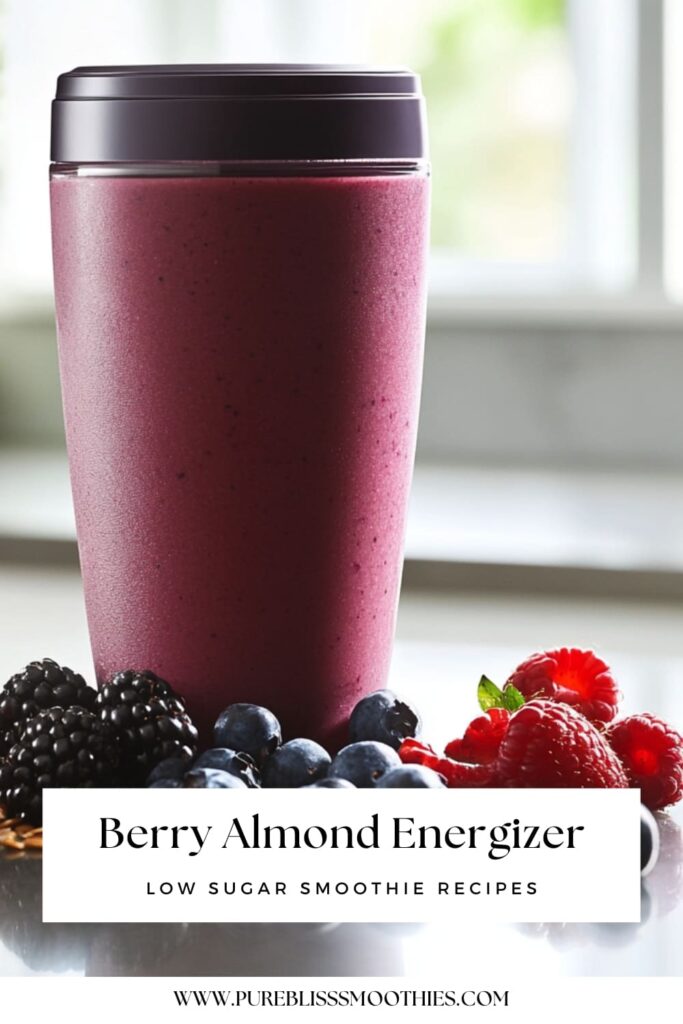
Ingredients:
- ¾ cup unsweetened almond milk
- ½ cup frozen mixed berries (blueberries, raspberries, blackberries)
- 1 tbsp almond butter
- 1 tbsp ground flaxseed
- 1 scoop unflavored protein powder (no added sugar)
- ½ tsp cinnamon
Directions:
Add the almond milk to your blender first, followed by the frozen berries, almond butter, flaxseed, protein powder, and cinnamon. Blend on high until smooth and creamy, about 30–45 seconds. If the texture is too thick, add a splash more almond milk and blend again. Serve immediately.
Why it works:
Berries are high in antioxidants and fiber while remaining low in sugar. Almond butter and flaxseed contribute healthy fats and slow-digesting nutrients that help manage appetite and energy. Protein adds staying power and supports metabolic function.
2. Green Glow Detox
This light, cleansing blend is ideal when you want something fresh, nourishing, and easy on digestion.
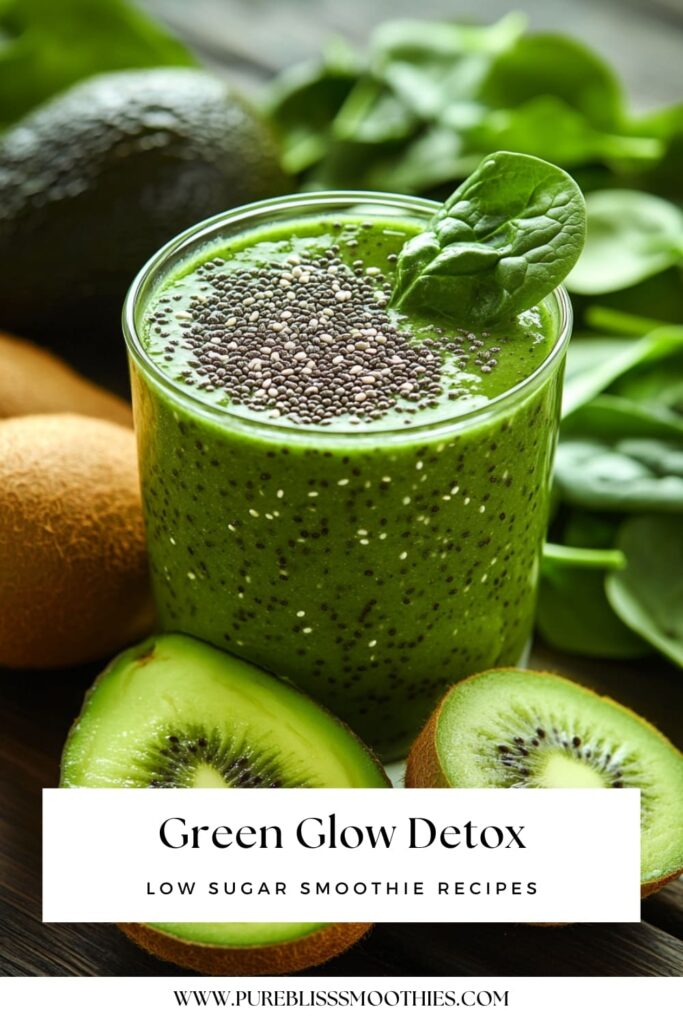
Ingredients:
- 1 cup water or unsweetened coconut water
- 1 cup spinach
- ½ avocado
- ½ kiwi, peeled
- 1 tbsp chia seeds
- Juice of ½ lemon
- Ice cubes (optional)
Directions:
Start by adding the liquid base to the blender. Then add spinach, avocado, kiwi, chia seeds, and lemon juice. Blend until smooth, around 45 seconds. If using ice cubes, add them after the first blend and blend again for a cooler, lighter texture. Let the smoothie sit for 2–3 minutes before drinking to allow the chia seeds to soften.
Why it works:
Spinach, avocado, and chia create a fiber-rich base that supports digestion and fullness. Lemon adds a refreshing zing while promoting liver health, and kiwi brings vitamin C and subtle sweetness with minimal sugar.
3. Choco-Coconut Smoothie
This is a satisfying choice when you want something rich and chocolatey—without the sugar or heaviness of a dessert shake.
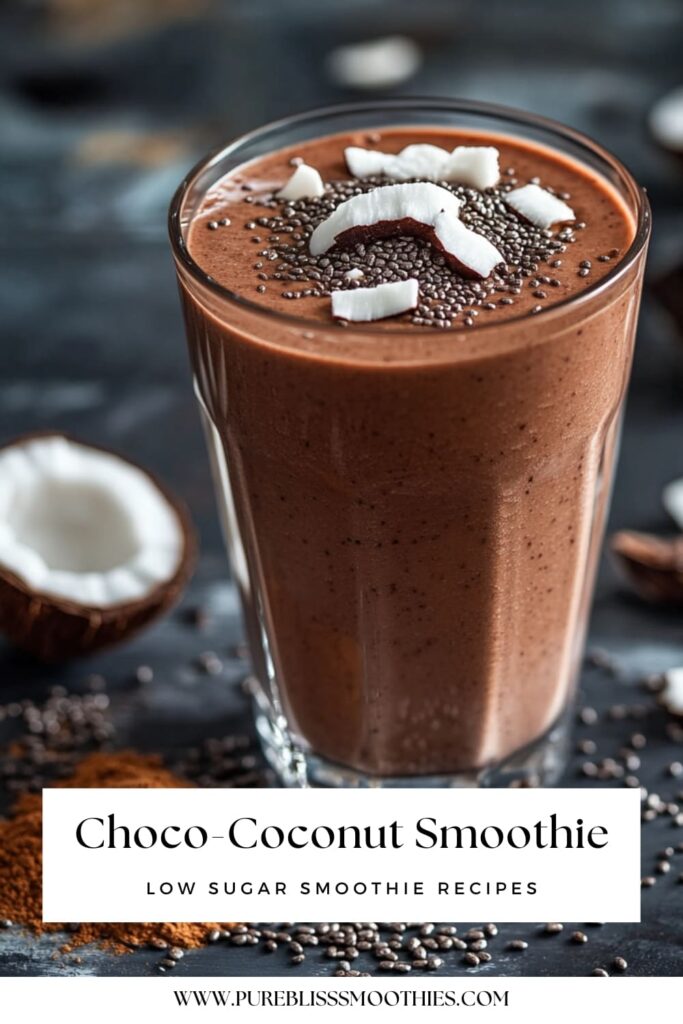
Ingredients:
- 1 cup unsweetened coconut milk
- 1 tbsp unsweetened cacao powder
- 1 tbsp shredded coconut (unsweetened)
- 1 tbsp chia or flaxseed
- 1 scoop unflavored protein powder (no added sugar)
- Optional: pinch of monk fruit or stevia for extra sweetness
Directions:
Pour the coconut milk into the blender. Add cacao powder, shredded coconut, chia or flaxseed, protein powder, and sweetener if using. Blend on high for about 45 seconds, or until the mixture is smooth and well combined. You can adjust the consistency with a little extra coconut milk if needed. Drink fresh.
Why it works:
This smoothie delivers rich flavor without sugar. Cacao provides antioxidants, while coconut and seeds offer healthy fats and fiber to help with blood sugar control and appetite regulation. Protein adds balance and makes it more satisfying.
4. Watermelon Mint Refresher
Cool, crisp, and ultra-hydrating—this blend is especially refreshing in warm weather or after a workout.

Ingredients:
- 1 cup diced watermelon
- ½ cup cucumber, peeled if preferred
- 5–6 fresh mint leaves
- Juice of ½ lime
- ½ cup water or ice cubes
- Optional: 1 scoop unflavored protein powder (no added sugar)
Directions:
Add watermelon, cucumber, mint, lime juice, and water (or ice) to the blender. If using protein powder, add it last. Blend on high for about 30 seconds, or until the mixture is completely smooth and slightly frothy. Serve chilled for a refreshing, hydrating smoothie.
Why it works:
Watermelon is low in sugar by volume and high in water, making it a perfect hydrating base. Mint and lime add natural flavor while supporting digestion. The optional protein helps turn this light blend into a more complete snack or meal.
5. Vanilla Spice Smoothie
A creamy, comforting blend with warm spices—great for a late-afternoon snack or a gentle start to your day.

Ingredients:
- ¾ cup unsweetened almond or oat milk
- 2 tbsp Greek yogurt (unsweetened, full-fat)
- ½ tsp vanilla extract
- ½ tsp cinnamon
- 1 small date or ½ tsp monk fruit (optional)
- 1 tbsp chia seeds
- Ice cubes
Directions:
Start by blending the almond or oat milk with the date (if using) to break it down fully. Then add Greek yogurt, vanilla extract, cinnamon, chia seeds, and ice cubes. Blend until smooth and creamy—about 45 seconds. If you prefer a thinner consistency, add a little more milk and blend again. Let sit for a minute or two to allow the chia to expand slightly before drinking.
Why it works:
Greek yogurt provides protein and creaminess without added sugar. Chia seeds contribute fiber and healthy fats, while vanilla and cinnamon offer flavor and blood sugar-friendly benefits. A single date adds a touch of sweetness without going overboard.
These five smoothies are intentionally crafted to deliver flavor, balance, and results. By focusing on ingredients that are naturally low in sugar and rich in nutrients, you can build a daily habit that supports your metabolism, hormonal health, and energy levels.
Tips to Make Low Sugar Smoothies a Daily Habit
Making low sugar smoothies part of your daily routine doesn’t have to be time-consuming or complicated. With a little planning and a few smart strategies, you can streamline your prep, improve flavor consistency, and maximize the nutritional impact of every smoothie you make
1. Prep Smart with Freezer Smoothie Packs
Batching your ingredients ahead of time can make a significant difference on busy mornings.
- Freeze single-serve smoothie packs by pre-portioning fruits, leafy greens, avocado, and seeds in reusable bags or containers.
- Store in the freezer for up to a month, then just add liquid and protein powder when ready to blend.
- For convenience, also portion dry ingredients like protein powder, flaxseed, or chia seeds into small jars or zip pouches.
Why it works: It reduces daily decision fatigue, saves time, and ensures you stay consistent—especially when you’re in a rush.
2. Adjust Sweetness Naturally
If you’re transitioning from high-sugar smoothies, your taste preferences may take time to adjust.
Here are a few ways to enhance flavor naturally:
- Add spices like cinnamon, nutmeg, or ginger for depth and subtle sweetness.
- Use vanilla extract to bring out sweetness in fruits like berries or kiwi.
- For a hint of sweetness without added sugar, use 1 small date, monk fruit, or stevia—but only if needed.
- Always blend first, then taste. Sometimes just a squeeze of lemon or lime is enough to balance bitterness and brighten flavor.
Tip: If your smoothie tastes flat, it’s usually due to under-seasoning or lack of acidity—not necessarily a lack of sweetness.
3. Choose the Right Time to Drink for Maximum Impact
Timing your smoothie intake can help support fat burning, energy levels, and hormone balance.
- Morning: A low sugar smoothie with protein and fat can support balanced blood sugar and reduce cravings throughout the day.
- Post-workout: After resistance training or a long walk, your body is primed to absorb nutrients. A protein-rich smoothie with some natural fruit can support muscle repair and recovery.
- Avoid late at night, as even natural sugars may disrupt sleep or digestion for some individuals.
Consistency matters more than timing, but aligning your smoothies with your energy needs can enhance results.
4. Enhance Results with Functional Add-Ins
Once your base is established, you can boost the benefits of low sugar smoothies by adding nutrient-dense extras:
- Greens powders – A concentrated source of vitamins and minerals when fresh greens aren’t available.
- Adaptogens (like ashwagandha or maca) – May support stress regulation and hormonal balance.
- Fiber supplements (such as psyllium husk or inulin) – Can aid digestion and improve satiety.
- Probiotics – Either in capsule form or added via plain Greek yogurt or kefir.
Choose one or two add-ins that align with your specific goals. Avoid overloading your smoothie, as too many extras can alter flavor and texture.
Making low sugar smoothies a daily habit is about planning, personalization, and consistency. By prepping ahead, adjusting flavor naturally, and timing your intake strategically, you can enjoy the benefits of better energy, improved focus, and sustainable fat loss—without added sugars or unnecessary complexity.
Conclusion
Integrating low sugar smoothies into your lifestyle is more than just a dietary shift—it’s a way to take control of your energy, your mood, and how you fuel your body. It allows you to stay focused on wellness without relying on sugar to satisfy cravings or provide quick bursts of energy. These smoothies can serve as a reliable, go-to option on busy days, a way to recover after exercise, or a simple tool to help you feel nourished without feeling restricted. And perhaps most importantly, they offer flexibility—adaptable to your preferences, your schedule, and your long-term health goals.
The success of any nutrition habit lies in how sustainable it is. When your smoothies are built on whole, nutrient-rich ingredients and tailored to your personal needs, they can support you through different stages of life, shifting routines, or evolving wellness priorities. With thoughtful preparation, simple ingredient swaps, and an understanding of how to build balance into each blend, low sugar smoothies become more than a quick fix—they become a practical foundation for better health, one day at a time.

